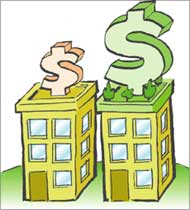 Any investor (buyer or seller) can optimize his taxable profits from real estate transactions with proper tax management. What one needs to do is work out the cost of purchase, the sales consideration and consequently the taxable profits.
Any investor (buyer or seller) can optimize his taxable profits from real estate transactions with proper tax management. What one needs to do is work out the cost of purchase, the sales consideration and consequently the taxable profits.
The first thing to work out is the difference in tax treatment for long-term and short-term capital gains (profits).
If the asset has been held for more than 36 months before sale, the profit is considered as long-term. Short-term profits are added to the individual's other income and taxed at appropriate rates. While computing long-term profits, indexation is allowed on the cost of acquisition.
Typically, capital gains are computed as under:
1. For net sale proceed deduct some costs from sale value. Sale value: Rs 50,00,000. Other charges: sale brokerage (Rs 1,00,000), incidental costs (say, lawyers' fees, Rs 10,000), transfer fees paid to society (Rs 10,000) and donation to society for transfer of flat (provided it can be shown that the society charges this donation as a matter of policy). Total: Rs 1,20,000. So, net sale would be Rs 48,80,000.
2. Deduct the following from the net sale proceed: cost of acquisition and improvement (for short-term profits) / indexed cost of acquisition and improvement (for long-term profits) = Rs 19,60,000 (assumed purchase price after indexation).
Add all the charges listed in the point above paid at the time of acquisition, for example brokerage paid then of, say, Rs 20,000. So, the capital gains would be Rs 30 lakh (48,80,000-19,80,000) 'Cost of improvement' would include major alterations carried out subsequent to the year of buying but not routine repairs and maintenance.
All the above deductions need proof so keep all bills or vouchers safely even if the purchase was made years back.
There is a perception that, in real estate transactions, some payment may be paid or received as unaccounted money and, hence, not recorded in the agreement. This reduces the real value and thus, the related stamp duty and income tax.
To curb this, many state governments have introduced the Ready Reckoner Index Value for calculating stamp duty. Under this, an RRIV is prescribed locality wise and is revised periodically.
The stamp duty is levied based on the RRIV, irrespective of the value mentioned in the sale agreement, which may be higher or lower than the RRIV.
At times, this can create tremendous hardships. In practice, the RRIV may not reflect the actual market rates in the locality or even of different locations in the locality. This became obvious in the recent past, when the RRIVs were not revised downwards though property prices were depressed.
In case the RRIV is higher, paying the additional stamp duty won't end the matter as the Income Tax Law (Section 50C) also adopts a similar concept. In other words, tax would have to be paid on sale profit based on the RRIV and not the actual profit. This means the seller pays tax on profits or income he hasn't earned.
Therefore, where the actual transaction value is below the RRIV, the parties should apply to the stamp act authorities for adjudication of the property's value giving full explanation.
In case you haven't got the value adjudicated and have paid the stamp duty as per the RRIV, the seller can still avoid Section 50C by requesting the tax officer to refer the matter to the valuation officer (VO).
When the VO visits, the reasons for the lesser consideration can be explained. If the fair market value (FMV) determined by the VO is lesser than the RRIV, the tax officer has to take the FMV as the correct figure. But, if the FMV is more, the RRIV stands.
The author is a chartered accountant and a member of Bombay Chartered Accountants Society.






